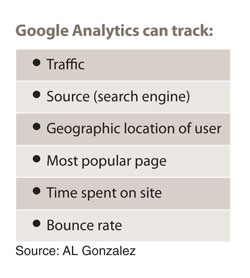Internet provides tools to analyze your online presence
Data from Google Analytics can help you optimize the relevance of your practice website.
 Agustin L. Gonzalez |
The Internet and its search engines are becoming an important part of our marketing to existing and potential patients. Do you understand how people find your website? How do you know if your content is relevant and useful to your prospective patients? Do you have any idea what is the most popular page on your website, or the amount of time people spend looking at the information?
Every website owner – including your practice – should be familiar with this data. Welcome to Google Analytics.
Google Analytics is a free resource that can be easily set up with any Google account. If you already have a Google account, search for “Google Analytics” and sign in with your gmail account.
Once you log on to Google Analytics you will identify the website you want to track, and Google will provide you with a code that can be copied and pasted at the top of each page in your website. This is how the tracking begins.
With analytics, you can monitor website traffic, the source (search engine), geographical location of the visitor, the most popular page, time spent on the website and “bounce rate.”
Traffic is usually measured by the number of “unique” visits your website receives over time. Unique visits helps identify the “false positive” visits that could falsely amplify your traffic, giving you a more accurate and overall idea of the popularity of your site.
 |
The source of traffic information tells you how people arrived to view your website. Search engine traffic, which is also known as “organic traffic,” is a direct measurement of success and perhaps ranking with search engine visibility. This is the most important statistic to watch, as the higher percentage of traffic arriving from search engines such as Google and Yahoo is a clear indicator of content-relevant information. This is also referred to as search engine optimization. Statistics on referring sites indicate the strength of links to your site. If you were to run an ad campaign on a particular page, this can be tracked as well.
Determining the location of the visitors to your site can be achieved in a number of levels. From country to state and town, you can monitor the effectiveness of your web presence in a certain geographical area. Google Analytics can even provide the IP address of the computer used to hit the site.
If you know what your most popular page is, you will know what topic interests people the most. By using analytics, I discovered there is more interest in dry eye therapy than floaters.
Time spent on the site and bounce rate reflect how relevant your page is to the reader. Bounce rate tracks how many people land on your website but do not stay, perhaps because it may not be the information for which they are searching.
Running analytics on your site can be a bit intimidating, but the information received can be insightful, with rewarding results. Once you have set up your website and become comfortable with the process, the value of information you obtain will clearly provide feedback on your work and help you better understand and fine tune your site.

- Agustin L. Gonzalez, OD, is in private practice in Dallas and serves as adjunct faculty at InterAmerican University. He can be reached at AG@txeyedr.com.
- Disclosure: Dr. Gonzalez has no direct financial interest in the products mentioned in this article, nor is he a paid consultant for any companies mentioned.
